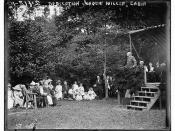George Miller explains that first, the span of absolute judgment and the span of immediate memory require strict limitations on the amount of information that we are able to receive, process, and remember. By organizing the stimulus input
all together into several dimensions and successively into a sequence
or amount, we manage to break this information in order to remember and process it later. Miller is saying that there is often far too much stuff going on around us to process and store in our memories, therefore we have to organize the information by categorizing it together to make better use of our brains resources. For example: If we think of a cat, dog and giraffe separately it can take more time and effort than if we were to group the objects together in a group called animals and which can then be extended to represent any 4 legged creature.
Next, the concepts and measures provided by his theory of information provide a new way of getting at some of these questions. The theory provides us with different ways for calibrating our stimulus materials and for measuring the performance of our subjects. Miller explains that the theory of information experiments about 'Absolute judgment' allow us to show that we can organize stimuli input and recode information, and therefore can enhance and expand the amount of information we are able to process. Miller has suggested that '7' has been an important figure throughout history, by identifying that many issues such as the days of the week and the deadly sins, occur in groups of 7's. He does highlight that this maybe coincidental, but also leaves it open for inquiry, as to whether there is an underlying reason for why these things happen in 7's.



George
I agree that 7 seems to be an approximate limit for remembering some types of information. Many believe it explains why telephone numbers are seven digits long.
8 out of 8 people found this comment useful.